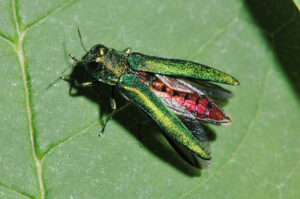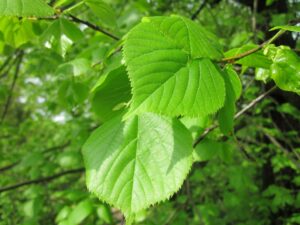Forestry
Many species of trees make up the City’s urban forest. Many native species, including oak, elm, basswood, maple, and paper birch, can be found in remnant forest parcels. Numerous nursery varieties have been planted by landowners. Each tree species comes with its own set of characteristics and problems.
Tree Inspection
The City of Gem Lake contracts its services to White Bear Township Public Works who provide free tree inspection for concerns or questions you may have about your trees. The Township routinely inspects all properties for oak wilt and Dutch elm disease. Township inspectors are watching for emerald ash borer symptoms in ash trees.
Emerald Ash Borer (EAB)
History
Emerald Ash Borer (EAB) has decimated the Ash trees in Minnesota. Native to Asia, it is likely the pest came over in wood packing material. The first U.S. identification was in Michigan in 2002 with its first confirmed appearance in Minnesota in 2009.
Emerald Ash Borer
Emerald ash borer (EAB) is an aggressive and invasive beetle that infects and kills ash trees. EAB attacks all species of North American Ash. EAB eggs are laid on the bark or in small cracks. Once larvae emerge from their egg, they tunnel into the cambial layer of the tree (the layer beneath the bark). The larvae are 1” to 1 1/4” when fully grown with a flat body and brownish head. At this point in development, the beetle has no legs. The larvae wind back and forth as they feed under the bark and create distinct, S-shaped tunnels in the wood and cutting off nutrient flow throughout the tree. Larvae feed under the bark until late fall and then winter in the tunnels they created. The fully-grown larvae live through the winter in these tunnels, transforming into pupae the following spring and from there into an adult. The adult beetle is a small green beetle that is not often seen. The adult beetle is 1/3” to 1/2” long with a slender body. They are bright green in color and may have a copper color just behind its head.
species of North American Ash. EAB eggs are laid on the bark or in small cracks. Once larvae emerge from their egg, they tunnel into the cambial layer of the tree (the layer beneath the bark). The larvae are 1” to 1 1/4” when fully grown with a flat body and brownish head. At this point in development, the beetle has no legs. The larvae wind back and forth as they feed under the bark and create distinct, S-shaped tunnels in the wood and cutting off nutrient flow throughout the tree. Larvae feed under the bark until late fall and then winter in the tunnels they created. The fully-grown larvae live through the winter in these tunnels, transforming into pupae the following spring and from there into an adult. The adult beetle is a small green beetle that is not often seen. The adult beetle is 1/3” to 1/2” long with a slender body. They are bright green in color and may have a copper color just behind its head.
Symptoms of EAB infestation
White Bear Township has found EAB throughout the City. On average, trees are killed within four years of being infested, though complete devastation can happen between two and five years. When first infected, symptoms are hard to notice, but often begin with blonding. Blonding is seen as light patches of bark often starting at the top of the tree. During the second year you may start to notice increased woodpecker activity and foliage thinning. By year three, canopy thinning is pronounced as is greater woodpecker activity. By the fourth year, canopy dieback has greatly increased, and you may see vertical bark splits in the main trunk.
What to do if you are concerned you have EAB?
First is to confirm that your tree is an Ash tree. Once confirmed, you can choose to treat or remove the tree. Treatment of a tree can be done proactively or during early infestation. Lightly infested trees that show little signs of decline can recover if treated. Infested trees with more than 50% of canopy dieback are not favorable for treatment. While treatment may be an option, it should be noted that treatment cannot reverse damaged that has been already caused by the EAB. The decision to treat, remove, or retain private trees rests with the property owner. Homeowners can use any tree contractor that is licensed in the City.
Arrest the Pest Hotline
Residents should learn about this threat to our ash trees and be on the lookout for infested trees. If you suspect a possible EAB infestation, call the MDA “Arrest the Pest Hotline” at 651-201-6684 Metro Area, or 888-545-6684 Greater Minnesota or Email Arrest the Pest.
Helpful Links
Emerald Ash Borer in Minnesota (University of Minnesota)
Emerald Ash Borer Management (MN Department of Natural Resources)
Emerald Ash Borer (MN Department of Natural Resources)
Emerald Ash Borer Information Network
Dutch Elm
History
Dutch elm disease was first found in Minnesota during 1961 in St. Paul and can now be found throughout Minnesota. The spread of Dutch elm disease in Minnesota was documented by the University of Minnesota.
Dutch Elm
Dutch elm disease is caused by a fungal invasion of an elm tree’s water conducting vessels. Dutch elm disease is exclusive to elm trees and does not pose any risk to other tree species. Once disease symptoms are observed, tree death can occur in as little as a few weeks. When a tree detects the fungus, it responds by plugging its vessels to keep the fungus contained, but the fungus remains ahead of the tree and essentially the tree causes its own death by cutting off the water supply.
disease is exclusive to elm trees and does not pose any risk to other tree species. Once disease symptoms are observed, tree death can occur in as little as a few weeks. When a tree detects the fungus, it responds by plugging its vessels to keep the fungus contained, but the fungus remains ahead of the tree and essentially the tree causes its own death by cutting off the water supply.
Signs of Dutch Elm Disease
Dutch elm disease symptoms appear 4-6 weeks after infection. The first noticeable symptom is wilting or “flagging” of one or more branches in the upper canopy of the tree. Leaves then turn dull green to yellow and brown, resulting in premature leaf fall. As the infection spreads, the wood beneath the bark becomes discolored as a result of fungal staining.
Residents should learn about this threat to our elm trees and be on the lookout for infested trees. If you suspect Dutch elm disease, call the MDA “Arrest the Pest Hotline” at 651-201-6684 Metro Area, or 888-545-6684 Greater Minnesota or Email Arrest the Pest.
How Does Dutch Elm Spread
DED is spread via beetle transmission and roots grafted with nearby infected trees. The most common method of spread is through beetle transmission. There are at least two kinds of elm bark beetles known to transmit the Dutch elm disease fungus; the European elm bark beetle and the native elm bark beetle. Female beetles lay eggs beneath the bark of dead and dying elm trees and/or firewood with tight bark. Newly hatched beetles emerging from infected elm trees carry the fungus on their body parts. The beetles fly to nearby elm trees to feed causing these trees to become infected with DED. Elm bark beetles feed exclusively on elm trees. Dutch elm disease also can spread into nearby healthy elms through roots that have grown together between two or more trees.
Helpful Links


